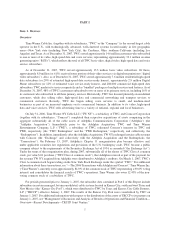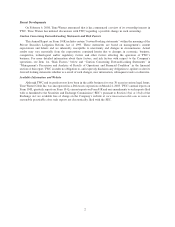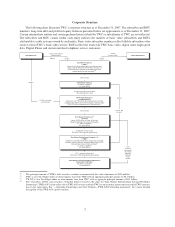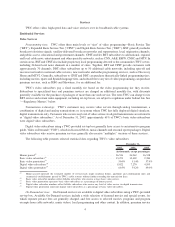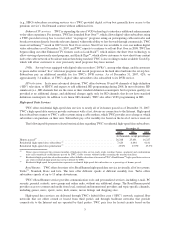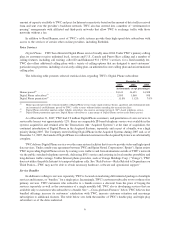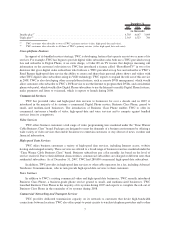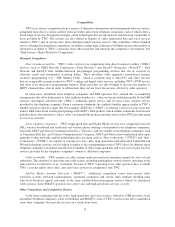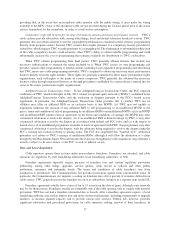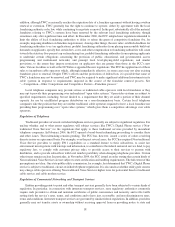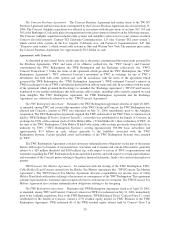Time Warner Cable 2007 Annual Report Download - page 16
Download and view the complete annual report
Please find page 16 of the 2007 Time Warner Cable annual report below. You can navigate through the pages in the report by either clicking on the pages listed below, or by using the keyword search tool below to find specific information within the annual report.Competition
TWC faces intense competition from a variety of alternative information and entertainment delivery sources,
principally from direct-to-home satellite video providers and certain telephone companies, each of which offers a
broad range of services through increasingly varied technologies that provide features and functions comparable to
those provided by TWC. The services are also offered in bundles of video, high-speed data and voice services
similar to TWC’s and, in certain cases, these offerings include wireless services. The availability of these bundled
service offerings has intensified competition. In addition, technological advances will likely increase the number of
alternatives available to TWC’s customers from other providers and intensify the competitive environment. See
“Risk Factors—Risks Related to Competition.”
Principal Competitors
Direct broadcast satellite. TWC’s video services face competition from direct broadcast satellite (“DBS”)
services, such as DISH Network Corporation (“Dish Network”) and DirecTV Group Inc. (“DirecTV”). Dish
Network and DirecTV offer satellite-delivered pre-packaged programming services that can be received by
relatively small and inexpensive receiving dishes. These providers offer aggressive promotional pricing,
exclusive programming (e.g., “NFL Sunday Ticket,” which is available only to DirecTV) and video services
that are comparable in many respects to TWC’s analog and digital video services, including TWC’s DVR service
and some of its interactive programming features. These providers are also working to increase the number of
HDTV channels they offer in order to differentiate their service from the services offered by cable operators.
In some areas, incumbent local telephone companies and DBS operators have entered into co-marketing
arrangements that allow both parties to offer synthetic bundles (i.e., video service provided principally by the DBS
operator, and digital subscriber line (“DSL”), traditional phone service and, in some cases, wireless service
provided by the telephone company). From a consumer standpoint, the synthetic bundles appear similar to TWC’s
bundles and also result in a single bill. For example, AT&T Inc. (“AT&T”) is offering a service in some areas that
utilizes DBS video but in an integrated package with AT&T’s DSL product, which enables an Internet-based return
path that allows the customer to order a video-on-demand-like product and other services that TWC provides using
its two-way network.
Local telephone companies. TWC’s high-speed data and Digital Phone services face competition from the
DSL, wireless broadband and traditional and wireless phone offerings of incumbent local telephone companies,
especially AT&T and Verizon Communications Inc. (“Verizon”), and also smaller local telephone companies, such
as Cincinnati Bell, Inc. and Citizens Communications Company. AT&T and Verizon have undertaken fiber-optic
upgrades of their networks, and the technologies they are using, such as “fiber-to-the-node” (“FTTN”) and “fiber-
to-the-home” (“FTTH”), are capable of carrying two-way video, high-speed data with substantial bandwidth and
IP-based telephony services, each of which is similar to the corresponding services TWC offers. In addition, these
telephone companies can market and sell service bundles of video, high-speed data and voice services plus wireless
services provided by the telephone companies’ owned or affiliated companies.
Cable overbuilds. TWC operates its cable systems under non-exclusive franchises granted by state or local
authorities. The existence of more than one cable system, including municipality-owned systems, operating in the
same territory is referred to as an “overbuild.” In some of TWC’s operating areas, other operators have overbuilt
TWC’s systems and/or offer video, data and voice services in competition with TWC.
Satellite Master Antenna Television (“SMATV”). Additional competition comes from private cable
television systems servicing condominiums, apartment complexes and certain other multiple dwelling units
with local broadcast signals and many of the same satellite-delivered program services offered by franchised
cable systems. Some SMATV operators now offer voice and high-speed data services as well.
Other Competition and Competitive Factors
Aside from competing with the video, high-speed data and voice services offered by DBS providers, local
incumbent telephone companies, cable overbuilders and SMATVs, each of TWC’s services also faces competition
from other companies that provide services on a stand-alone basis.
11


